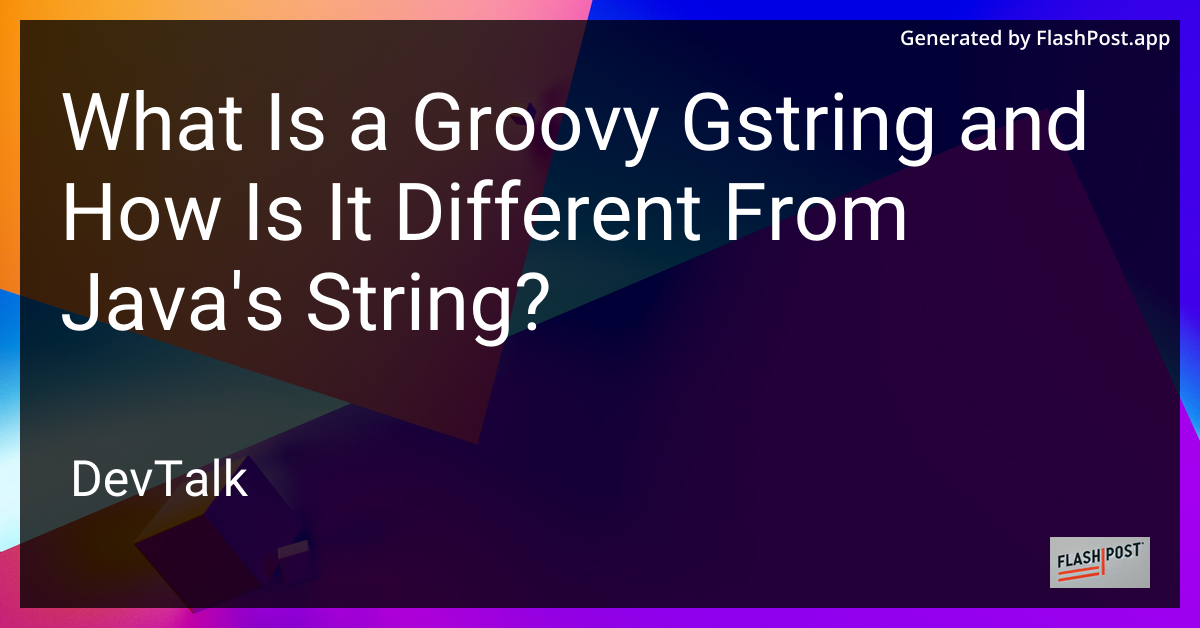What Is a Groovy Gstring and How Is It Different From Java's String?

What is a Groovy GString and How is it Different from Java's String?
In modern software development, working with strings is a common task across various programming languages.
Java and Groovy, two popular programming languages in the Java ecosystem, offer robust string handling capabilities. However, Groovy introduces a unique string representation called GString. This article explores what a Groovy GString is and how it diverges from Java's traditional String, alongside beneficial resources for Groovy development.
Understanding Groovy's GString
A GString is short for Groovy String and is a powerful feature in Groovy that extends the capabilities of Java Strings. What sets GStrings apart is their ability to perform string interpolation, which is the process of embedding variables or expressions directly within string literals.
Basic Syntax of GString
In Groovy, GStrings are created using double quotes ("), similar to Java Strings, but they allow the inclusion of placeholders with the $ symbol. Here's a basic example:
def name = "Groovy"
def greeting = "Hello, $name!"
println(greeting) // Output: Hello, Groovy!
In the above example, $name is the placeholder replaced by the value of the name variable at runtime.
Difference Between Groovy GString and Java's String
1. String Interpolation
The primary distinction between Groovy's GString and Java's String is string interpolation. Java Strings do not support embedding variables directly within strings. Instead, Java relies on methods like String.format() or concatenation operations.
Example in Java:
String name = "Java";
String greeting = "Hello, " + name + "!";
System.out.println(greeting); // Output: Hello, Java!
2. Mutable Contents
GStrings can evaluate expressions dynamically and hold mutable content contrary to Java Strings, which are immutable. GStrings can incorporate changes without creating new string objects until they are converted into Strings.
3. Performance Considerations
Since GStrings evaluate expressions at runtime, using them extensively in performance-critical sections might introduce overhead. Thus, it's crucial to optimize Groovy coding practices for efficient development here.
When to Use Groovy GStrings?
GStrings are particularly useful when dealing with dynamic data such as JSON transformation or when handling complex string operations. If you're working with intricate data structures, check out this guide on handling complex JSON data with Groovy.
Utilizing Groovy Regular Expressions
Another compelling feature Groovy offers is the enhancement of regular expressions. Groovy simplifies regular expression handling and provides powerful grouping features. For a deeper dive, explore this resource, which explains extended regular expression grouping in Groovy.
Conclusion
Groovy's GString offers significant advantages over traditional Java Strings by facilitating straightforward string interpolation and dynamic content handling. Understanding the nuances between these two string types enables developers to optimize string manipulations in their applications effectively. Embrace Groovy's rich features and refer to provided resources for mastering this dynamic language.
By leveraging GStrings alongside optimized Groovy coding standards, developers can create more readable, efficient, and maintainable code.
This markdown article is structured to provide clear insights into the differences between Groovy GString and Java String while integrating links to valuable resources for enhancing Groovy programming skills.